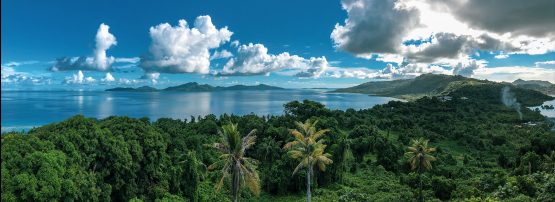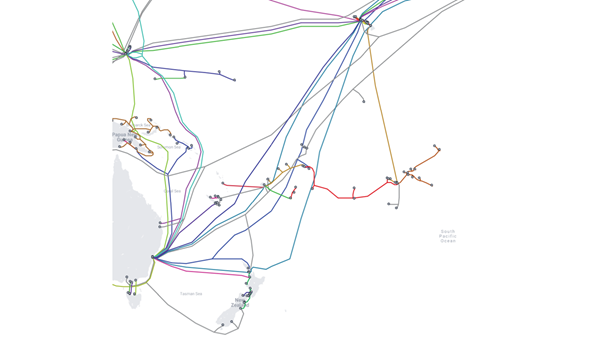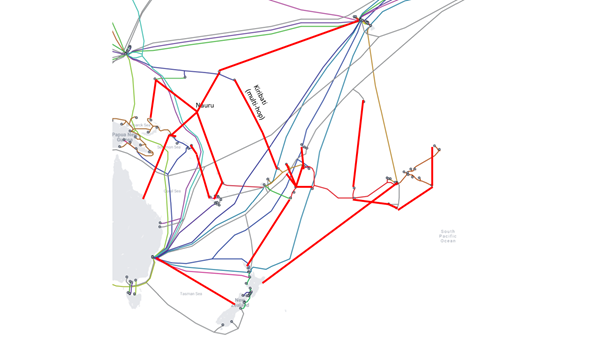
The recent catastrophic failures of Tonga’s international and domestic submarine cable systems in the aftermath of the Hunga Tonga Hunga Ha’apai (HTHH) volcanic eruption have put the spotlight onto Pacific Island Internet connectivity, with the resulting lengthy communication outages and impairments causing significant impacts on the wellbeing of the people and their economies. Discussions with several parties around resilience in this area have led me to believe the approach to cable projects in the Pacific needs a fundamental rethink. This blog explains why, and what’s needed.
How cabling projects in the South Pacific typically happen
This section will necessarily generalize and shouldn’t detract from the wonderful pioneering work that has been done to date by so many determined individuals and organizations across the Pacific.
Read: At the bottom of the sea: a short history of submarine cables
A cable project in the South Pacific typically has its genesis when an island economy realizes that satellite Internet just isn’t as powerful as a cable. The locals see what their family and friends in Australia, New Zealand (NZ), and Hawaii have at home or at their place of business and aspire to the same. But they’re hundreds of kilometres away from the nearest place where they could tap into the international fibre networks, so connecting is an expensive proposition. In most cases, we’re talking many millions of dollars.
But, to their credit, they have high aspirations and are enterprising people, so they’ll seek supporting partners to get an initiative off the ground such as Australia, NZ, US, Japan, EU, and agencies such as the ADB, IMF, World Bank, and so on. They’ll cite poverty, low GDP, digital divide, and opportunities for development. Rightfully so. Eventually, they’ll get a business case and the funding together, source a cable layer to assist them (perhaps with some old cable pulled up from elsewhere) and then, after a bit of economizing on repeater spacing, eventually the long-awaited cable arrives a few years down the track. And with it, Internet heaven.
That heaven lasts until the cables break. For Tonga, that’s already happened twice on each of their cable systems. And as we have just learned, when turbidity currents break a cable after a major volcanic eruption or submarine landslides, many dozens of kilometres of spare cable are needed to fix the problem. In the case of Tonga, that was a lot more than the cable ship could acquire when they raided their stores in Apia, Samoa, enroute to the Tongan cable grounds. Spares cost money, as does their storage, and many cable systems have operated for decades without significant failures.
Read: When volcanoes go bang, submarine cables do … what?
Yet, when cables fail because of major events like the HTHH eruption, they fail at the very moment they are needed the most. With even the first connection being a financial exercise at the limits of the island economy’s capability, getting a redundant cable in via a different route, away from potential natural hazards, is a project that many consider beyond reach (although Tonga is planning such a second cable).
What’s wrong with this picture?
Now, who would begrudge an island their aspiration to become connected to the Internet? Nobody. And aren’t there all those international funding agencies for whom these are great projects to support, and whose launch makes for great photo ops, and things to put into their annual reports? Sure. No complaints here. But let’s examine a few repeat features of this approach and what it leads to:
- Almost all such cable projects are driven exclusively by an island community that wants to get connected. They’re almost never driven by larger economies wanting to help the islands get connected. Very few manage to exploit the synergies of connecting multiple economies and islands along the way.
- In most cases, the cable is a dead end; it terminates in an endpoint from which there is only local connectivity. There is no transit traffic and no benefit from peering. One end of the cable supplies, the other consumes.
- Few projects create resilient redundancy for other existing cables.
- Practically all are one-off projects, requiring cable ship resources to be brought in from far away. For maintenance, this can mean a cable layer that is weeks away in case of a breakdown, or — the expensive alternative — paying a cable ship closer by to sit on idle standby for literally years on end. There is no significant amount of standardization in terms of cable technology across systems, and the warehousing of spares happens on a per-system basis.

The big nation perspective
Larger economies and organizations in the region only participate as donors but cannot leverage these cables as redundancy for their own cable systems because they literally lead nowhere from their perspective. At best, they’re seeing island connectivity as extra load on their own international connectivity.
In some cases, larger economies have significant populations from the island economies. For example, NZ is home to a large diaspora of Tongans, Samoans, Niueans, Tokelauans, Cook Islanders, and Fijians, to name a few, with the diaspora having a larger head count than the island population in some cases. However, the connectivity of these larger economies often rests on a relatively small number of fibres thinner than a human hair and often bundled in just a handful of cables. While there is some redundancy, it’s still somewhat precarious, and not at the level economies with millions of people would ideally like to be connected at. But running a cable all the way across the Pacific is a project that even they cannot afford on an annual basis — once a decade is more on the time scale of economies like NZ.
Read: Meeting the challenges of a Pacific-wide network
Then there are large economies with interest in the South Pacific such as the US and its partners, China, France, Japan, and Taiwan. While they all share a seat on the Pacific Ring of Fire, they don’t have the Pacific at the top of their agendas, in part because their economies are focused on other parts of the world, and in part, due to similar susceptibility to natural disasters — volcanoes, earthquakes, tsunami, cyclones/typhoons, some with the potential of significant region-wide destruction.
The big powers also witness the world’s shifting attention to issues that put the Pacific at the centre like climate change, ocean pollution, fisheries, and the science that goes with it. In fact, there is an awful lot of science going on in the region, including very large and data-intensive projects such as the Square Kilometre Array (SKA) in Australia and the telescopes in Hawaii. However, there is a lot more science that could be done in the Pacific if there was appropriate connectivity. David Lassner, a well-known entity in networking circles in the Pacific and current President of the University of Hawaii System, gave an impassioned keynote at the 2019 IEEE GlobeCom conference in Hawaii, telling the world’s top telecoms people why the Pacific was important for the global telecommunication community!
So, in my opinion, it’s time for the big powers in the region to stop merely asking what they can do for the islands in terms of cable projects. It’s time to come together at a regional level to discuss mutual benefits for large and small economies, in the sphere of submarine fibre networks.
Let’s dream a bit.
A Pacific mesh utopia
Globally speaking, the South Pacific is a region with a few larger developed economies on the periphery and many smaller — mostly developing — island economies, dispersed between them.
Read: Talking underwater: Recent developments in Asia Pacific subsea communication
The former realize that their own connectivity needs to evolve over time and aspire to build with as much redundancy and geographical diversity as possible to minimize the risk of disruption due to natural disasters or deliberate interference. They understand that good connectivity on islands assists in growing business and social relationships and recognize that investing in island connectivity is to their advantage.
The small island states are strategically positioned between the larger economies. In this 2030 utopia, most cable systems no longer run dead-end spurs to islands. Instead, islands serve as natural transit and peering venues. By then, this will have created a mesh with an abundance of redundant paths between all parties, greatly enhancing their resilience against cable outages.
Adding fibre capacity to a large economy is now a matter of running a cable to the nearest island that is part of the mesh, or a matter of upgrading bottlenecks of a few hundred (or at most a few thousand) kilometres. Then, monolithic 12,000+ km transpacific cables would become less crucial.
Island economies now have more access points to choose from in their neighbourhood. The access points are closer, and the cable routes of new cables become shorter. Shorter hops and advances in fibre technology have reduced the need for expensive submarine repeaters, bringing down the cost of the physical cables.
Because of the number of cable systems involved, the Pacific can now sustain a small fleet of cable ships engaged in laying and maintenance. These cable ships are permanently based in the region as there is significant ongoing work. Projects are no longer lumbered with huge overheads for lengthy cable ship commutes from faraway seas. Maintenance contracts no longer build in charges for long periods of ship idle time as the ships are no longer so idle. Cable damage that once took several weeks to repair can now be fixed in a few days.
Continuous demand for cable simplifies spares warehousing and has even led to the establishment of a cable manufacturing plant in the region.
More and more islands have achieved sustainable connectivity with redundant and cheaper connections. Satellite capacity has been redeployed to the smallest islands.
The mesh operates on a stakeholder basis, overseen by an international not-for-profit organization that manages the fundraising process and commissions and operates most of the cables. It prioritizes the cable projects and liaises directly with the region’s governments and regulators, as well as with major service providers, for example, in the content delivery network space.
Donors that would have once contributed to one-off cable projects now provide ongoing large strategic investment to the organization, but this is dwarfed by contributions from the larger economies, with significant sums being provided by private investors. Island economies still contribute to the cable projects that connect them, but no longer bear the heavy financial burden they once did.

Could it actually be done?
Yes, but two things need to happen. Firstly, small island economies will need to realize that they can be so much more than just aid recipients at the end of a long road. Likewise, larger economies in the region will need to recognize the benefits of a mesh architecture for resilience, and the advantage that small islands offer as nodes in such a highly resilient mesh.
Secondly, there needs to be a multilateral initiative to kickstart the organization that will make it all happen. This requires strong leadership from and collaboration among the established economies.
The cables shown in Figure 2 as thick red lines could probably be constructed for around USD 1B as a rough ballpark figure. This might sound like a lot of money to a small island economy, and it is, but the US government alone spent USD 6.8T in 2021.
To put it another way, if a foreign government sends a frigate to the South Pacific to show its presence there, as governments from the region and beyond do on a regular basis, USD 1B per frigate is roughly the amount of capital they commit in doing so. Yet, arguably, a mesh of the kind proposed would bring significantly more stability, prosperity, and resilience to the region than a frigate. Most cables serve for decades, so that initial cost would be amortized over time.
Dr Ulrich Speidel is a senior lecturer in Computer Science at the University of Auckland with research interests in fundamental and applied problems in data communications, information theory, signal processing and information measurement. The APNIC Foundation supported his research through its ISIF Asia grants.
The views expressed by the authors of this blog are their own and do not necessarily reflect the views of APNIC. Please note a Code of Conduct applies to this blog.

Thanks Dr Ulrich, what an interesting read and perspective. Certainly, on point with regard to redundancy and scalability and worth us Island countries really looking into it like what happened recently in my country PNG.